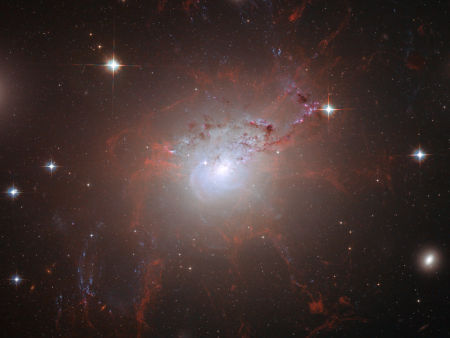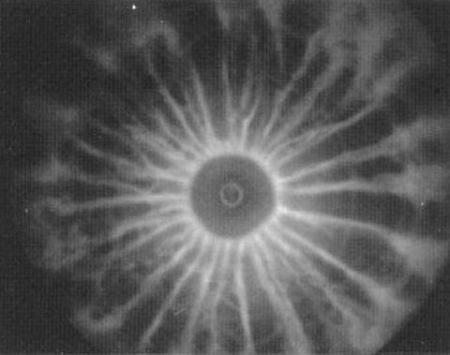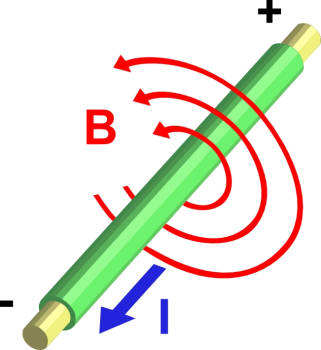Phil Plait - Bad Astronomer vs. Good Science
08/28/08
There’s nothing like a good controversy! And this is nothing
like a good controversy… Phil Plait opens his mouth and spews polemic
nonsense. Furthermore, he exposes astronomers’ biased ignorance about
the source of magnetic fields: electric currents.
|
|
|

The gravity-defying plasma filaments of NGC 1275!
Credit: NASA, ESA, and the Hubble Heritage (STScI/AURA)
-ESA/Hubble Collaboration
|
|
|
In a recent
press
release, it has been shown that the galaxy NGC 1275 emanates
filamentary tendrils of plasma. Furthermore, magnetic fields have
also been found in association with the tendrils.
However, nobody but the Thunderbolts group has thus far made the
logical
leap from a discussion of the magnetic fields to a discussion
of the electrical processes that are required to spawn them.
In a highly unscientific dig at the Electric Universe model, by proxy,
Phil Plait (something of a self-proclaimed expert on astronomy) has
both shown his true colors and his ignorance. Rather than engaging in
scholarly dialogue with the primary proponents of the Electric Universe
model or citing primary sources, he has instead chosen to issue little
more than
straw
man polemic nonsense couched in an otherwise seemingly scientific
article.
Magnetism is a very important topic in astrophysics (despite some
pseudoscientists lying and saying this force is ignored), but it’s
not well-understood. It’s fiendishly complex, so much so that it’s
a joke in astronomy: when giving a colloquium about an astronomical
object’s weird features, saying it’s due to magnetism will always get
a chuckle out of an audience. And it’s a standard joke that if you
want to derail a talk, ask the speaker about the effects of magnetism.
In three dimensions, magnetism is ferociously difficult
to model.
[Emphasis added.]
In addition to the misrepresentative statements included in the polemic
diatribe, Plait also exposed astronomy’s biggest blind spot. However,
the blind spot isn’t magnetic fields, as he erroneously claims
the Electric Universe model denies that the standard model studies, but
electric currents in space (which the Electric
Universe model does say have been more-or-less ignored by standard
model astronomers and cosmologists like Plait).
In astronomy, the discussion of electric currents appears to be
verboten. It is a standard joke around here that if you want to
get banned in record time at just about any astronomy forum, mention the
word "electricity" and apply its defined relationship with
"magnetic fields" to space. Astronomers apparently don’t like
having their blind spots pointed out to them.
However, that is precisely the thing that holds astronomy back from
real answers. Plait is apparently unaware of the works
of Maxwell, Ampere, Lorentz and Faraday, or he would recognize the source
of the magnetic fields in the cosmos, which he and other astronomers have
such a devilish time modeling.
Magnetic fields are predicated upon electric currents. In
The
Simplified Case for Cosmic Electrodynamics, readers learned that
electric currents and magnetic fields are intimately related.
What
Are Electromagnetic Fields?
Electric fields are created by differences in voltage:
the higher the voltage, the stronger will be the resultant field.
Magnetic fields are created when electric current flows:
the greater the current, the stronger the magnetic field. An electric
field will exist even when there is no current flowing. If current does
flow, the strength of the magnetic field will vary with power consumption
but the electric field strength will be constant.
Electric currents spawn magnetic fields. Magnetic field strength depends
upon the strength of the electric current. That is the principle behind
the modern
electromagnet,
Phil! Magnetic fields are also diagnostic for electric currents in the
lab, when it’s impossible or inconvenient to interrupt a circuit and
insert a measuring device directly.
Ignorance of this basic physical fact, or claims to the contrary (that
electric currents don’t flow in space or "don’t do anything"),
should embarrass Plait and his cohorts in the astronomical community who
steadfastly refuse to acknowledge the role of currents in space. They
sorely need the counsel of a qualified electrical engineer and/or plasma
physicist before the good name of the "queen of the sciences"
is tarnished any further.
The simple fact of the matter is that the standard model of cosmology
prefers not to deal with electric currents if at all possible and thus
artificially creates its own blind spot. It speaks of magnetic fields
as if they are a sole cause and not the byproduct effect of another
process.
Ignorance of the work of Maxwell, Ampere, Faraday and Lorentz cannot be
allowed to stand, if astronomy wishes to make any actual advances in our
understanding of how the universe truly functions without reference to
unproven, unobservable ‘new physics’ such as ‘dark matter,’ ‘dark energy,’
‘inflation,’ etc.
In a prior
Thunderblog, it was revealed that the Milky Way’s stellar halo is
composed of "star streams" (filaments of stars). The standard
model claims these filaments somehow survived intact or were created by
the merger of one or more dwarf galaxies with the Milky Way, and were
gently woven around it. From the Plasma Cosmology/Electric Universe
point of view, such filaments are an
expected feature of currents threading the plasma universe, wherein
plasma and electrical processes scale from the smallest to the largest.
Now it would seem that NGC 1275 is yet another poster child for
filamentation in
cosmic plasma. In fact, it demonstrates the scalability of plasma processes
and the fractal nature of the
plasma filaments.
Long gaseous filaments stretch out beyond the galaxy, into the multimillion-degree,
X-ray-emitting gas that fills the cluster.
[…]
Exploiting Hubble's view, a team of astronomers led by Andy Fabian from
the University of Cambridge, UK, have for the first time resolved individual
threads of gas that make up the filaments.
To paraphrase, the largest filaments are composed of smaller filaments
(which are themselves most likely composed of yet smaller filaments and so on).
|
|
|

Those who read the Thunderbolts TPODs or
Holoscience news
items may have seen one or another
article mentioning the
dense
plasma focus.
|
|
|
Just as the dense plasma focus creates a hollow filament composed of
sub filaments, it may be that the "gaseous filaments"
observed by Hubble are derived from a common genesis: electric currents
in plasma forming large filaments composed of smaller and smaller filaments.
Given that the filaments observed by Hubble are composed of more filaments,
and all of it appears to be a good fit with electric currents in plasma,
it should come as no shock that such currents would produce magnetic fields.
In a related bit of physics, the byproduct magnetic fields can interact
with the original current in such a way as to make it more compact. This
is commonly known as a
"pinch"
(also known as a "Bennett pinch," "Z-pinch,"
"electromagnetic pinch," "magnetic pinch,"
"plasma pinch" or the "pinch effect").
It seems that astronomers have gotten us half way to the answer. They have
observed the magnetic fields involved and they have observed the filaments
of plasma involved. They have
hypothesized
that "somehow" the magnetic fields hold the plasma filaments in
place against gravity.
A
new
study published in the Aug. 21, 2008 issue of Nature magazine proposes
that magnetic fields hold the charged gas in place and resist the forces
that would distort the filaments. This skeletal structure is strong enough
to resist gravitational collapse.
However, they have thus far failed to give electric currents in plasma their due.
This oversight seems silly to proponents of Plasma Cosmology or the Electric
Universe model, in light of the very definition of the relationship between
electric currents and their byproducts: magnetic fields.
To resolve the puzzle once and for all, it is necessary for astronomers
like Phil Plait to definitively acknowledge the relationship between
electric currents and magnetic fields as well as the role that electric
currents play in the cosmos. It is necessary to understand that where
magnetic fields are seen, by definition, we MUST consider
what the source electric currents are doing if we wish to completely
understand the processes that are going on. If we can determine the strength
and direction of the magnetic fields involved, then we should be able to work
backward and determine where the electric currents are located and their
relative strengths. Then it’s simply a matter of mapping the electrical
circuitry of the cosmos.
In fact, some efforts are already underway to map the cosmos. The results
thus far show an interconnected
web of
plasma filaments and sheets with voids in between. Galaxies appear to
be oriented non-randomly, implying they form along the observed filaments like
beads
on a string.
Other research also indicates that the universe may display a
fractal
distribution of matter at the largest scales, contrary to assertions
that distribution should smooth out on the largest scales, according
to the theory of "inflation." If this is so, it is a
fatal
blow to the standard model/big bang paradigm, since such large-scale
structure should not have had sufficient time since the Big Bang to
form. Such a fractal distribution is, however, predicted by Plasma
Cosmologists.
It remains to be seen whether astronomers wish to continue in their
befuddlement with magnetic fields whose genesis appears unknown to
them, or whether they wish to acknowledge that electric currents play
an integral role in the functioning of the universe. This simple
understanding may be the pivot point upon which to turn an entire
discipline.
Hint: Electromagnetism
|
|
|

|
|
|
Electric current [I] produces a magnetic field [B]. The magnetic
field can be visualized as a pattern of circular field lines surrounding
the wire.
Electric current can be directly measured with a galvanometer, but
this method involves breaking the circuit, which is sometimes
inconvenient. Current can also be measured without breaking the
circuit by detecting the magnetic field
associated with the current.
Once electric currents are readmitted to the astronomical lexicon
and toolkit, many false notions will fall away shortly thereafter
as the explanatory power of electrical processes unlock the secrets
of many heretofore "mysterious" energetic processes that
have been observed in the universe.
For now, we content ourselves to sit and watch with amusement as
Plait and his astronomer friends trip over themselves in an attempt
to understand those “ferociously difficult to
model” magnetic fields.
Michael Gmirkin
|
|
|
Permalink to this article.
Public comment may be made on this article on the
Thunderbolts Forum/Thunderblogs (free membership required).
|
|
|
|
|

Michael Gmirkin is a technology enthusiast with a keen interest
in exploring the electrical nature of the universe.
My Archives
Chronological Archives
Archives by Author
Archives by Subject
Thunderblogs home
|







